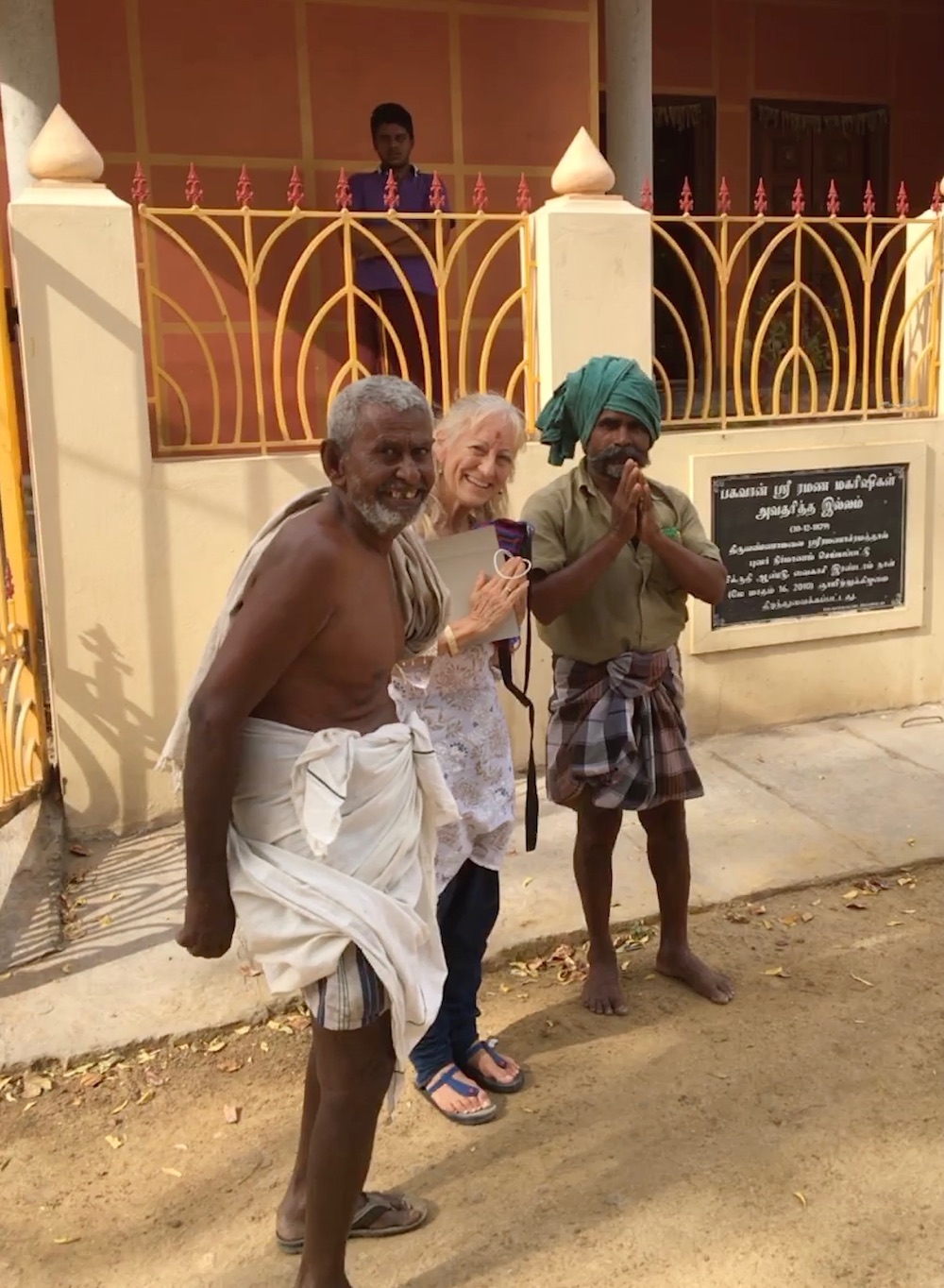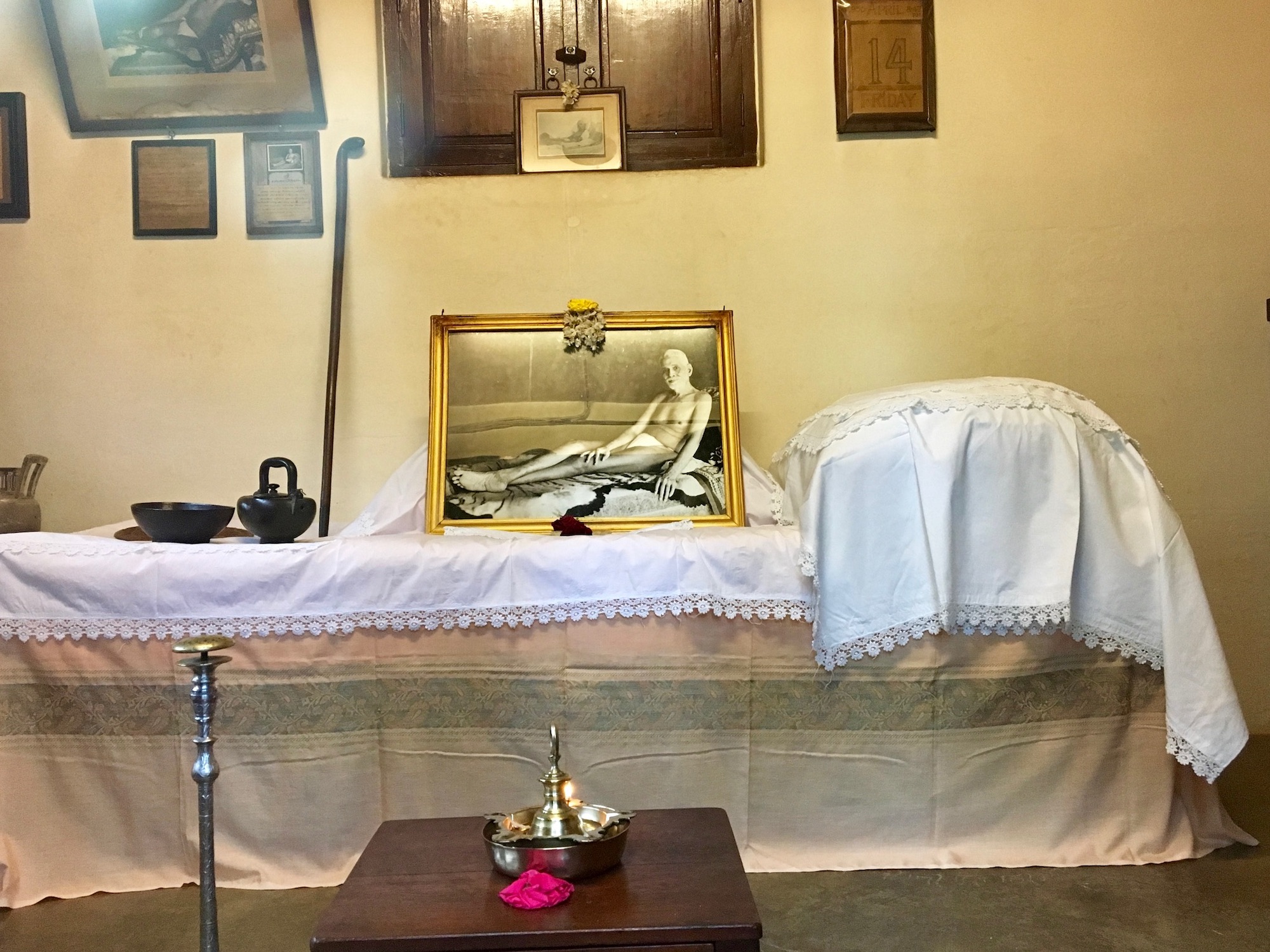
By Renée Tillotson
It’s been exactly seven years ago since this story happened, yet I only now feel ready to share it with you, my dear readers. It was such a personal experience, I suppose I’ve needed time to process and put words to it.
With the goal of the heart finding its still center, please allow me to tell you about our visit to the birthplace of one of India’s great teachers of the 1900s. Sri Ramana Maharshi’s teaching boils down to one simple, central question: “Who am I?”
My husband Cliff and I arrived in March 2017 at Ramana’s ashram at the base of Arunachala, a long-revered mountain in southern India. Here we encounter hundreds of spiritual seekers who pour through Ramana’s spiritual retreat daily from both India and abroad. Sacred cows amble through the ashram’s pathways and monkeys mischievously scramble about. Human residents and visitors all walk barefoot, most with third eye marks on their foreheads.
Priests perform pujas (ceremonies) with sacred statues, mantras, flowers, milk, fire and the like. Ramana Ashram includes common Hindu trappings of what can be a deeply complex, metaphysical tradition. Yet Ramana’s words are simple and direct as we listen to them read aloud in the main prayer hall. Here are a few of my notes on what we heard:
Nothing holds you back from realizing your divinity but your own small self-conceptions. There is no ego – it simply does not exist. There is no individual self – that is an illusion.
When I heard the voice of my inner teacher telling me to be silent, completely wordless, I realized a profound, endless bliss. It had been there all the time.
We don’t need a guru giving us sets of things to do and not to do. We just need to examine until we see the emptiness of our concept of a personal self.
Here in Ramana Ashram outside the town of Tiruvannamalai, this man with a profoundly simple teaching directly touched the lives of thousands within his lifetime, and millions more since then through the words that his followers transcribed and continue to publish. Perhaps the photographs taken of Ramana equally convey his life teaching through his eyes.
Cliff and I watch with both astonishment and amusement as teen and pre-teen priests begin entering the hall. Some walk with great deliberation, others come skittering in at the last moment. They seem so young to take such holy vows. Each boy has a mostly-shaved head, wears a sacred thread across one shoulder, a floor-length white cloth wrapped around his waist, and sacred ash across his forehead.
Once assembled in front of the altar area, the youths raise their voices together, drowning out the concluding words of Ramana’s chapter. The boys’ high pitches are balanced by the voices of older Indian men in attendance for whom these ancient chants seem to course undeniably through their being, like the blood through their bodies. Meanwhile, older priests conduct an elaborate puja behind the chanting boys, while Hindus and wanna-be Hindus alike slowly circumambulate the ceremonial area, round and round.
Long after we leave the ceremony, the mantras thrum through my mind so persistently, I have to ask myself whether my ears are still actually hearing the sound. Or do these age-old chants perpetually lap, like timeless waves, through the waters of my consciousness?
Perhaps the mantras help drown out the chattering voices that can daily fill my head. Sound covers sound, allowing intervals of silence – the deep silence that Ramana suggests that we abide in.
I intuit that finding the heart’s still, silent center cannot be rushed.
A few days before that visit to Ramana Ashram, one of the more significant experiences of my life took place. Cliff and I had the privilege of visiting the home where Ramana was born in 1899. Ramana has been a favorite spiritual light of ours for decades, and Cliff has read dozens of books about his life and teachings.
We approach Ramana’s now-public birth home. A friendly beggar standing watch at the front gate announces our arrival. A tall, kind Indian woman opens the door. Both her face and her gestures gently beckon us in.
Given the relative poverty of this village, we assume that the marble floors we see are an honorific beautification someone has added in recent years. What remains of the original home? I wonder. The stately yet humble woman of the house takes us to a small room with simple, original furnishings. This room, she indicates, is where Ramana was actually born. We can hardly believe we are finding ourselves in this sacred place.
Next, she leads us to an equally small room where Ramana died – so to speak – at age 16. When he regained consciousness from his death-like experience, he was an utterly changed young man. What had died was his personal ego, he later reported. Within a month, he left school, home and family to live on Arunachala mountain, where he remained until his bodily death in 1950.
Remaining wordless for years, Ramana exuded a radiant presence and peace-bestowing eyes that gathered many followers to him on the mountain, unbidden. Eventually, when he began to speak, he asked his followers the question: What is the source of your sense of “I”?
Entering the room where the sixteen-year-old underwent his transformative death experience, Cliff and I have the opportunity to sit quietly before an almost life-sized photograph of the adult Ramana. I have seen this photo before, but here, for the first time I realize that those compassion-filled eyes looking directly through the camera into my soul – are always upon me, no matter where I go in the room, sitting or standing. I sense an almost palpable depth of presence. I feel as if the light of Ramana’s essence is reaching into me, filling me to the brim and beyond.
The woman and her husband invite us to sign the guest book before we leave. The husband was born the year after Ramana died. He says that he never met any of Ramana’s immediate disciples, though his family has care-taken the house for 5 generations.
This is a quiet place, barely on the map of pilgrimage sites, yet this husband and wife dedicate their lives to Ramana’s memory, welcoming the occasional pilgrim. It saddens me that this devoted couple keeps such a remarkable spot available for the world, yet so few of even Ramana’s followers come to experience it. At seeing how indelibly touched we are by visiting his birth home, the wife’s eyes fill with tears as she bids us goodbye.
Both her eyes and Ramana’s fill my heart, effortlessly leading me to its still center.
This week we celebrate Maha-Shivaratri – one of the holiest days on the Hindu calendar. You can read two other stories of our 2017 trip to South India at the time of Maha-Shivaratri here:










Renée Tillotson
Renée Tillotson, Director, founded Still & Moving Center to share mindful movement arts from around the globe. Her inspiration comes from the Joy and moving meditation she experiences in the practice of Nia, and from the lifelong learning she’s gained at the Institute of World Culture in Santa Barbara, California. Engaged in a life-long spiritual quest, Renée assembles the Still & Moving Center Almanac each year, filled with inspirational quotes by everyone from the Dalai Lama to Dolly Parton. Still & Moving Center aspires to serve the community, support the Earth and its creatures, and always be filled with laughter and friendship!

Get the Still & Moving App
This post is also available in: 日本語 (Japanese)





